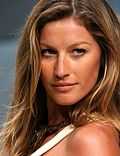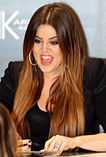Ombré
Ombré describes the gradual blending of one color hue to another, usually moving tints and shades from light to dark.[1] The technique is commonly seen as a surface treatment in fashion and art. During the early 21st century ombré became a popular feature for hair coloring, nail art, and even baking, in addition to its uses in home decorating and graphic design.[2]
In fashion
History
Ombré technique has been used a very long time. Ombré fabric printing, using a special printing block called an 'ombre' or 'rainbowed' block, was used in the early 19th century to produce textiles with graduated colour designs.[3] Ombre as a textile treatment came back into fashion in around 1840 and was used throughout the 19th century.[3][4] In machine embroidery an ombré effect was achieved by dyeing the threads in graded colours beforehand.[5]
21st century


Ombré as a hair colouring technique is believed to have been popularised in 2007 when the supermodel Gisele Bündchen had her hair dyed in a subtle gradual fade from dark brown at the roots to lighter towards the hair tips.[6] The ombré hair trend was still popular in 2014.[7] The style has been adopted by many A-list celebrities such as Alexa Chung, Lauren Conrad, Nicole Kidman, Beyonce, and even Jared Leto, among others.[7] The ombré hairstyle requires very little upkeep, making it easier for it to remain on trend.[2] While ombré was initially the gradual lightening of the hair from dark to light, it has expanded to take on various other techniques, including the fading of a natural color from the roots to a more unnatural color (such as turquoise or lavender) at the tips.
The popularization of ombré hair encouraged the spread of the ombre technique to other facets of beauty, such as nail art. The adoption of the ombré nails trend by celebrities like Lauren Conrad, Victoria Beckham, and Katy Perry helped popularise it.[8]
Other uses
Home

Following the early 21st century trend, many popular home decorators have incorporated ombré into their home decorating styles. Martha Stewart describes the gentle progression of color in ombré as a transition from wakefulness to slumber.[9] Ombré can be used in many products from textiles to glassware, and as a wall-painting technique, where walls are painted in colours graduating to a lighter or darker tone towards the other end.
Baking
In baking, ombré effects are typically achieved through applied techniques such as frosting on a cake; but it is possible to bake individual cake layers in graduated tones from light to dark.[10][11]
References
- ↑ "Ombré". http://www.oxforddictionaries.com''. Oxford Dictionaries. Retrieved 30 October 2014.
- ↑ 2.0 2.1 Meghan Gourley (6 November 2013). "Ombré: a ubiquitous word for that faded look". New York Times. New York Times. Retrieved 30 October 2014.
- ↑ 3.0 3.1 "Wedding dress, 1841. Block-printed cotton.". Search the Collections. Victoria and Albert Museum. Retrieved 19 November 2014.
- ↑ "Long Purse, late 19th century". Philadelphia Museum of Art: Search Collections. Philadelphia Museum of Art. Retrieved 19 November 2014.
- ↑ "Machine embroidered trimming, 1853.". Search the Collections. Victoria and Albert Museum. Retrieved 19 November 2014.
- ↑ "History of Ombré". Gordon Salon. Gordon Salon. 17 July 2014. Retrieved 30 October 2014.
- ↑ 7.0 7.1 "Ombre Hair". Marie Claire. June 17, 2014. Retrieved October 30, 2014.
- ↑ The Nailasaurus (1 May 2012). "Nail Art Alert! How To Get Ombre Nails At Home". Glamour. Glamour. Retrieved 30 October 2014.
- ↑ Martha Stewart (May 2008). "Ombré Craft Projects". Martha Stewart. Martha Stewart Living. Retrieved 30 October 2014.
- ↑ "What is an ombre cake". Encyclopedia of Things. Baking Bites. 26 August 2014. Retrieved 31 October 2014.
- ↑ "Ombré cakes and cupcakes: shortcut to a hot trend". King of Arthur flour. King of Arthur flour. 27 September 2013. Retrieved 1 November 2014.